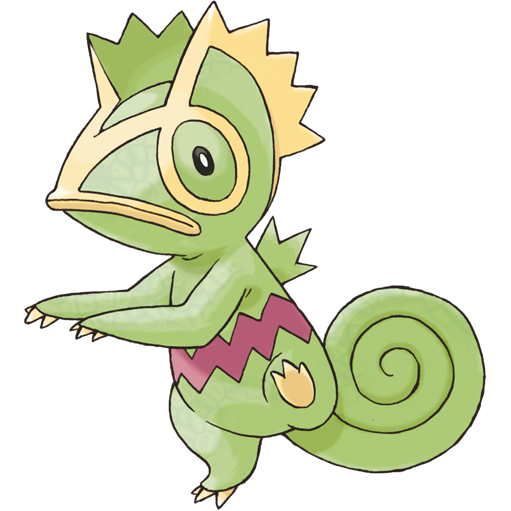|
|

Artwork from R/S/E
|
|
|
|
|
|
|
|
|
|
|
|
Height
3′03″
Imperial
|
1.0 m
Metric
|
3′03″/1.0 m
Red-Striped
|
0'0"/0.0 m
Blue-Striped
|
0'0"/0.0 m
|
|
|
Weight
48.5 lbs.
Imperial
|
22.0 kg
Metric
|
48.5 lbs./22.0 kg
Red-Striped
|
0.0 lbs./0.0 kg
Blue-Striped
|
0.0 lbs./0.0 kg
|
|
|
|
|
|
|
|
|
|
|
|
|
EV yield
HP
0
|
Atk
0
|
Def
0
|
Sp.Atk
0
|
Sp.Def
0
|
Speed
0
|
| Base Exp.: 132
|
Battle Exp.: 1321*
|
|
|
|
|
Kecleon (Japanese: カクレオン Kakureon) is a Template:Type2 Pokémon, however, its ability, Color Change, allows it to become any type, depending on the moves used against it.
It is not known to evolve into or from any other Pokémon.
Biology
Physiology
Kecleon is a greenish reptilian Pokémon. It has yellow rings around the eyes as well as having yellow lips and frills. Kecleon has small ridges on its shoulders and a red zigzag stripe on its back. Kecleon has a long skinny tail that is usually curled in a helix shape.
Kecleon can sometimes have purple as their natural color instead of green. It is possible that Kecleon can come in other colors.
Gender differences
None.
Special abilities
Kecleon can Template:A2 to match its surroundings. This can make it difficult to find. Its stripe, however, never changes.
Kecleon's other skills in battle include the capability to wield various elemental attacks, Ghost/Dark moves (such as Sucker Punch and Shadow Claw and a handful of Psychic abilities (such as Psybeam and Trick Room.
Kecleon is incapable of learning Hyper Beam or Giga Impact, despite the fact that it might be a fully evolved Pokémon, and it is a Template:Type2.
Behavior
Kecleon often hide by changing its color to match its surroundings in order to avoid being found.
Habitat
Kecleon live in forests.
Diet
- Main article: Pokémon food
In the anime
Kecleon first appeared in The Kecleon Caper and was the first Generation III Pokémon to appear in the anime. A pair of them tried to foil Team Rocket's attempt to steal their owner's stuff.
A Kecleon was one of the Pokémon that played Hide 'n' Seek with Pikachu and the others in Pikachu's PikaBoo. However, said Kecleon missed out on the excitement when a lawn-mower was on the loose. The end of the short finds Kecleon standing in the same spot, wondering where everyone is. It was not found because it was invisible.
Harrison used a Kecleon against Ash's Pikachu in the Silver Conference in Playing with Fire and Johto Photo Finish. It finally lost to Pikachu after an intense battle.
A Kecleon appeared in a Pokémon Chronicles episode that took place in Big Town. It was stealing food to take to an Azumarill's sick niece.
Two Kecleon owned a shop in Pokémon Mystery Dungeon: Team Go-Getters out of the Gate!. Unfortunately, Team Meanies bought out everything they had.
Angela used a Kecleon to train her team of ninjas in From Cradle to Save.
A Kecleon appeared in Pruning a Passel of Pals!.
The Kecleon Brothers appeared in Pokémon Mystery Dungeon: Explorers of Time & Darkness.
In the TCG
- Main article: Kecleon (TCG)
Game data
NPC appearances
- Pokémon Pinball: Ruby & Sapphire: Kecleon has the first Bonus Field on the Ruby Field. It will turn invisible, though a Devon Scope can be knocked out of the tree to make it visible for a short time. Kecleon must be knocked over and then hit with the ball ten times in two minutes to win the round.
- Pokémon Mystery Dungeon: Two Kecleon run the shop at Pokémon Square. Other Kecleon will randomly have shops within dungeons. They are normally courteous but shoplifting will result in multiple wild Kecleon appearing to attack the player. While these Kecleon are at an extremely high level and hard to recruit, this is the only way to obtain Kecleon in the game.
Pokédex entries
| This Pokémon was unavailable prior to Generation III.
|
|
|
|
|
| Generation III
|
|
| Ruby
|
Kecleon is capable of Template:A2 at will to blend in with its surroundings. There is one exception - this Pokémon can't change the zigzag pattern on its belly.
|
| Sapphire
|
Kecleon Template:A2 to blend in with its surroundings, allowing it to sneak up on its prey unnoticed. Then it lashes out with its long, stretchy tongue to instantly ensnare the unsuspecting target.
|
| Emerald
|
A Pokémon that has the ability to Template:A2 to match its surroundings. A Kecleon reverts to its original colors if it is startled.
|
| FireRed
|
It changes body color to blend in with its surroundings. It also Template:A2 if it is happy or sad.
|
| LeafGreen
|
It changes body color to blend in with its surroundings. It also Template:A2 if it is happy or sad.
|
|
|
| Generation IV
|
|
| Diamond
|
It can freely change its body's color. The zigzag pattern on its belly doesn't change, however.
|
| Pearl
|
It can freely change its body's color. The zigzag pattern on its belly doesn't change, however.
|
| Platinum
|
{{{platinumdex}}}
|
| HeartGold
|
{{{heartgolddex}}}
|
| SoulSilver
|
{{{soulsilverdex}}}
|
|
|
|
|
|
|
Game locations
| This Pokémon was unavailable prior to Generation III.
|
|
|
|
|
|
|
|
|
|
|
|
|
In side games
Base stats
| Stat
|
Range
|
| At Lv. 50
|
At Lv. 100
|
60
|
|
120 - 167
|
230 - 324
|
90
|
|
85 - 156
|
166 - 306
|
70
|
|
67 - 134
|
130 - 262
|
60
|
|
58 - 123
|
112 - 240
|
120
|
|
112 - 189
|
220 - 372
|
40
|
|
40 - 101
|
76 - 196
|
Total: 440
|
Other Pokémon with this total
|
- Minimum stats are calculated with 0 EVs, IVs of 0, and (if applicable) a hindering nature.
- Maximum stats are calculated with 252 EVs, IVs of 31, and (if applicable) a helpful nature.
|
Type effectiveness
| Under normal battle conditions in Generation V, this Pokémon is:
|
|
|
|
|
|
|
|
|
|
|
|
|
Note that the numbers above ignore the effects of Kecleon's ability; this is for Kecleon if it is of Template:T2. For the weaknesses/resistances of any other type, please see the page on that type.
Learnset
Template:Learnset intro
Note: With the use of Color Change, any damaging move can theoretically become a STAB for Kecleon.
|- style="text-align:center"
| style="text-align:left" | normal
| style="background:#9FA19F" | normal
| style=" background:#FFF" | 4
| style=" background:#FFF" | 3
| style=" background:#FFF" | Kecleon
| style="display:none; background:#FFF" | {{{6}}}
Template:Mlentry4
Template:Mlentry4
Template:Mlentry4
Template:Mlentry4
Template:Mlentry4
Template:Mlentry4
Template:Mlentry4
Template:Mlentry4
Template:Mlentry4
Template:Mlentry4
Template:Mlentry4
Template:Mlentry4
Template:Mlentry4
Template:Mlentry4
Template:Mlentry4
Template:Mlentry4
Template:Mlentry4
Template:Mlentry4
Template:Mlentry4
Template:Mlentry4
Template:Mlentry4
Template:Mlentry4
Template:Mlentry4
Template:Mlentry4
Template:Movelist/note
Template:Movelisttm
Template:Mlentry4
Template:Mlentry4
Template:Mlentry4
Template:Mlentry4
Template:Mlentry4
Template:Mlentry4
Template:Mlentry4
Template:Mlentry4
Template:Mlentry4
Template:Mlentry4
Template:Mlentry4
Template:Mlentry4
Template:Mlentry4
Template:Mlentry4
Template:Mlentry4
Template:Mlentry4
Template:Mlentry4
Template:Mlentry4
Template:Mlentry4
Template:Mlentry4
Template:Mlentry4
Template:Mlentry4
Template:Mlentry4
Template:Mlentry4
Template:Mlentry4
Template:Mlentry4
Template:Mlentry4
Template:Mlentry4
Template:Mlentry4
Template:Mlentry4
Template:Mlentry4
Template:Mlentry4
Template:Mlentry4
Template:Mlentry4
Template:Mlentry4
Template:Mlentry4
Template:Mlentry4
Template:Mlentry4
Template:Mlentry4
Template:Mlentry4
Template:Mlentry4
Template:Mlentry4
Template:Mlentry4
Template:Mlentry4
Template:Mlentry4
Template:Mlentry4
Template:Mlentry4
Template:Mlentry4
Template:Mlentry4
Template:Mlentry4
Template:Mlentry4
Template:Mlentry4
Template:Movelist/note
Template:Eggmoves
Template:Mlentry4
Template:Mlentry4
Template:Mlentry4
Template:Mlentry4
Template:Mlentry4
Template:Mlentry4
Template:Eggmoves/note
Template:Tutor
Template:Mtentry4
Template:Mtentry4
Template:Mtentry4
Template:Mtentry4
Template:Mtentry4
Template:Mtentry4
Template:Mtentry4
Template:Mtentry4
Template:Mtentry4
Template:Mtentry4
Template:Mtentry4
Template:Mtentry4
Template:Mtentry4
Template:Mtentry4
Template:Mtentry4
Template:Mtentry4
Template:Mtentry4
Template:Mtentry4
Template:Mtentry4
Template:Mtentry4
Template:Mtentry4
Template:Mtentry4
Template:Mtentry4
Template:Mtentry4
Template:Mtentry4
Template:Mtentry4
Template:Mtentry4
Template:Mtentry4
Template:Mtentry4
Template:Mtentry4
Template:Mtentry4
Template:Mtentry4
|- style="background:#9DC1B7"
| colspan="13" | Bold indicates a move that gets STAB
Italic indicates a move that gets STAB only from an Evolution of this Pokémon
A colored initial indicates that the move is not available to be tutored in this game,
while a colored background indicates that the move is available.
|}
|}
Side game data
Template:Side game
Evolution
Template:Evobox/0
Sprites
Trivia
- Kecleon is one of the five Pokémon that can turn into a pure Template:Type2 Pokémon. The others are Arceus while holding the Sky Plate and Porygon, Porygon2, and Porygon-Z by using Conversion 2 after being hit by a Template:Type2 move.
- Kecleon is the hardest Pokémon to recruit in Pokémon Mystery Dungeon, with a base recruit rate of -33.9%. It can only be recruited if the player is level 90 or higher, and if they are holding a Friend Bow. Even after all this, Kecleon's recruit rate is only 0.1%.
- Color Change can be used against Kecleon by harming it with a move of one type, then using a move that type is weak to. This works especially well with Template:Type2 and Template:Type2 moves, which weaken their own type, though Ghost-type moves cannot be used as soon as Kecleon appears.
- During Emerald Version's sprite animation, Kecleon disappears completely, but in the anime when it turns invisible, the red stripe can still be seen.
- The "fins" on Kecleon's back are absent in its official Sugimori artwork.
- Kecleon, along with Wailmer and Azurill, was one of the first Generation III Pokémon revealed. It was also the first Generation III Pokémon seen in the anime, in The Kecleon Caper.
- In the Pokémon Mystery Dungeon series, Kecleon is the first Pokémon to feature an alternate coloration that is not its shiny coloration.
- In the anime, a purple Kecleon has yellow stripes on it's face, while a purple Kecleon in the Pokémon Mystery Dungeon series will have mint green stripes instead.
Origin
Kecleon is based on a chameleon.
Name origin
Kecleon's name, a corruption of its Japanese name, may be a combination of 隠れる kakureru, to hide, and chameleon. It might also come from Jeckyll, because Kecleon changes colors like Dr. Jeckyll changed personalities, or 'keck' which means 'to treat scornfully', which may refer to the fact that many players developed a good-sized grudge against Kecleon because they couldn't get into the Fortree City Gym without the Devon Scope.
In other languages
External links

|
This Pokémon article is part of Project Pokédex, a Bulbapedia project that aims to write comprehensive articles on each Pokémon species, as well as Pokémon groups and forms.
|

























